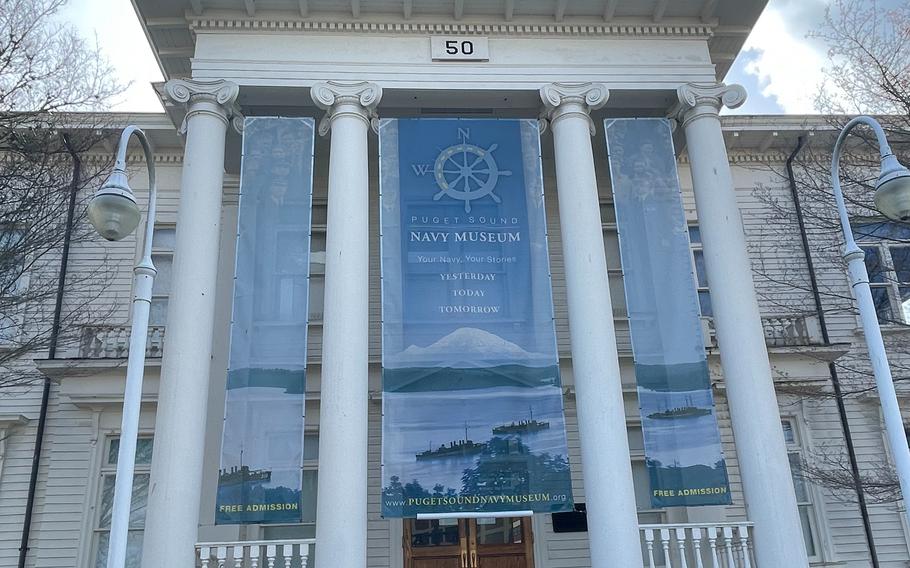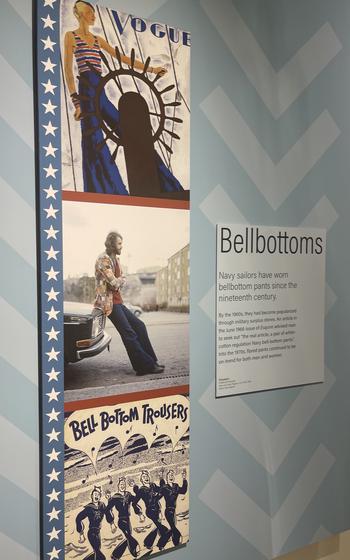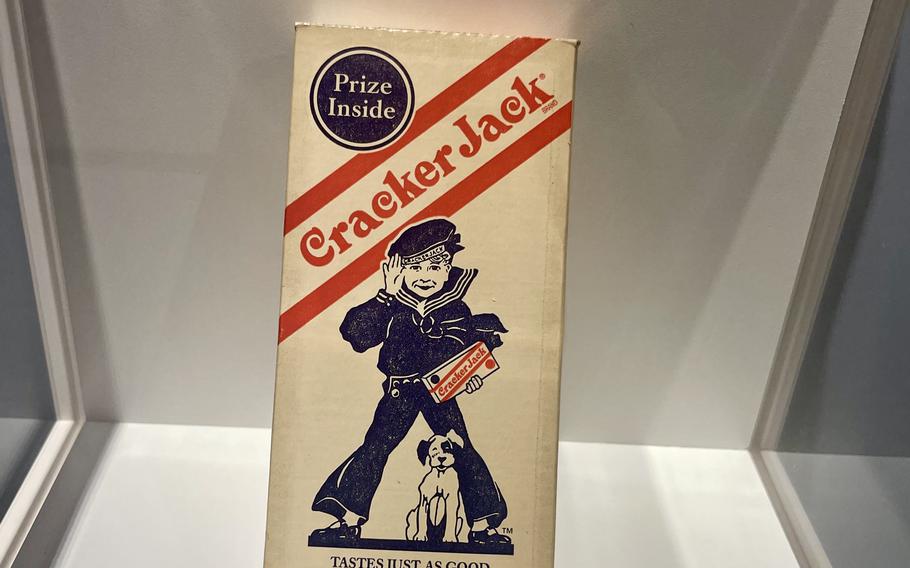
The former Navy command headquarters in Bremerton, Wash., now houses the Puget Sound Navy Museum. (Gary Warner/Stars and Stripes)
The Beatles’ psychedelic bell bottoms for “Sgt. Pepper’s Lonely Hearts Club Band.” Marlon Brando’s white t-shirt in “Streetcar Named Desire.” Rhianna and other celebrities sporting baggy dungarees. The cast of “Jaws” skidding around a boat in Top-Siders to avoid becoming lunch for a gigantic shark.
All these looks have roots in the Navy. The uniforms of sailors spawned civilian fashion trends still popular today.
The journey from the high seas to cultural icons is told in a new exhibit, “A Salute to Style: Fashion and the U.S. Navy” at the Puget Sound Navy Museum in Bremerton, Wash.
The exhibit chronicles the crossover of designs of uniforms and gear created for practical purposes of working at sea. Some became worldwide couture trends. A few sank like an unchained anchor.
The classic sailor suit was called the Crackerjack. The blue uniform had a square collar with a flap on the back, pants with a 13-button front flap, and wide legs known as bell bottoms. Introduced in 1894, it was the uniform of Navy junior enlisted until the end of the Vietnam War in 1973.
The Crackerjack inspired the caramel corn snack of the same name with a drawing of a boy in a sailor suit on the box front.
The most significant cultural impact was likely the trousers — with bell bottoms ironically becoming the rage of the counter-culture fueled by opposition to the Vietnam War in the 1960s and early 1970s.
The roomy pants with wide flared cuffs were designed to allow sailors maximum movement as they bent around ship machinery and climbed steep metal staircases leading to engine rooms and ammunition magazines.
Models such as British pop favorite Twiggy wore bell bottoms in fashion magazine photo shoots. The Beatles and Rolling Stone were among the many rock and roll bands that took the stage in bell bottoms. Eric Clapton wrote “Bell Bottom Blues” about a man distraught at losing his flared pants-wearing lover.
Hippies in San Francisco heeded a 1966 Vogue magazine advice to look for “the real article” and head to Army-Navy surplus stores for cast-off sailor pants.
The bell bottom craze spread to American clothing manufacturers, and in the 1970s, they became popular everywhere, from elementary schools to corporate offices.

An exhibit on bell bottom pants at the Puget Sound Navy Museum in Bremerton, Wash. (Gary Warner/Stars and Stripes)
What started out as an undergarment issued to sailors in 1910 became a pop culture favorite after World War II.
The undershirt became the only shirt for sailors working in steamy climates, from the gunboat diplomacy of patrolling Chinese rivers in the 1920s to the scorching island-hopping Pacific campaign in World War II.
By the 1950s, the t-shirt was a look of choice for working men who wanted to show off their muscles. Brando, Steve McQueen, and others have adopted minimalist cover-ups in movies.
The warm coats were adopted by early Navy fliers — as well as their Army counterparts. Up until World War II, many aircraft used by the military featured cockpits exposed to high altitude cold.
Even with a windshield, the torrent of air passing over their torsos was bone-chilling.
With more planes having enclosed and pressurized cockpits, the elements were less in-your-face, but the flight jacket look remained popular, especially on the ground as a status statement. Even pilots today who never held the stick of a open cockpit Navy training Stearman PT-17 have adopted the jackets of those who had before their time. They were followed by civilians who didn’t have to fly to wear flyboy jackets.
Paul Sperry didn’t like slipping on his sailboat, so he toyed around with soles until coming up with the bottom of his Sperry Top-Siders in 1938. His biggest market would be the Navy, which assigned shoes with his soles to every sailor who went to sea. Many U.S. Naval Academy cadets adopted the stylish boat shoe, according to the museum. They became favored footwear to all who went down to the sea in ships.
Denim pants had been around for quite a while — the name comes from Dongri, a village near Mumbai, India, where the rugged fabric pants trace back to the 17th century.
The modern version received a major boost in 1913 when it became an official work uniform of the Navy. They could stretch when reaching around machinery and didn’t show stains like other fabrics.
Before World War II, the pants could only be worn inside a ship. The Navy loosened the rules, but dungarees were the one uniform that sailors never were to be seen in off-base. But the casual denim — sometimes worn with a variation that includes a denim bib and straps — caught on for work and as an ultra-casual look for actors, singers, and other celebrities trying to avoid notice or at least the spotlight.
The exhibit also dives into some Navy uniform ideas that sank out of sight.
After World War II, the Navy wanted a more modern look than the Crackerjacks. The enlisted Navy uniform briefly became a variation on the corporate suit and tie in the years after World War II.
The exhibit says sailors soon complained that the businessman-style attire was uncomfortable for work aboard the ship, making it difficult to stow in cramped lockers without wrinkling and challenging to repair.
The look got another shot in the 1973 under Chief of Naval Operations Admiral Elmo Zumwalt. One survey found that more than 80 percent of sailors said they didn’t like wearing the Crackerjack — especially in public.
“Sailors were complaining that “bells” did not make them feel like men,” wrote Brent Hunt in the Sextant, a Navy History and Heritage Command publication. “At the same time, the CNO was getting letters from spouses who said they were embarrassed to go to the store or church with their husbands dressed like little boys.”
Zumwalt ordered a more egalitarian-looking service uniform that didn’t starkly differentiate between officers and enlisted.
“One Navy, one uniform,” was Zumwalt’s slogan of choice.
Over time, sailor’s opinions flipped. By the end of the 1970s, a survey found that an overwhelming majority wanted to ditch the new pseudo-office attire. Modern variations in blue and white of the old Crackerjack look were back.

An exhibit on the Crackerjack snack at the Puget Sound Navy Museum in Bremerton, Wash., Nov. 16, 2024. (Gary Warner/Stars and Stripes)
The military-wide move to camouflage uniforms led the Navy to introduce the highly unpopular Navy Working Uniform Type 1 in 2008. The blue and gray uniforms were mocked from the start, with sailors calling them “Aquaflage” and noting that wearing ocean-colored camouflage at sea would make it hard to spot a sailor who had fallen overboard. The dead knell for the uniform came when it was discovered the fabric was not sufficiently flame retardant. The uniforms were phased out for sea-serving sailors in 2019, though a reworked camouflage uniform can be worn by Navy personnel on land.
The exhibit includes cartoons on the right way and wrong way to wear the Navy sailor “dixie cup” cap, the popularity of the Navy pea coat, integrating women’s uniforms into the once all-male Navy, and the repurposing of old uniforms with all the emblems of unit and rank into aprons for loved ones back home.
The museum plans on keeping the Navy fashion exhibit well into 2025.
The Puget Sound Navy Museum is adjacent to the Puget Sound Naval Shipyard and the Washington State Ferries terminal. Frequent daily ferries run between downtown Seattle and Bremerton. The museum can also be visited from Seattle via the Tacoma Narrows Bridge.
The museum is one of 10 operated by the Naval History & Heritage command.
Permanent exhibits cover the shipyard’s history, including repairing battleships sunk and refloated after the World War II attack on Pearl Harbor. A chunk of flak from the attack is on display.
The permanent collection also spotlights Nimitz-class nuclear-powered aircraft carriers. Puget Sound Naval Shipyard is part of Naval Base Kitsap, currently home to two of the carriers — USS Nimitz and USS Ronald Reagan.
The museum is open 10 a.m. to 4 p.m. every day except Tuesday. Admission is free. 251 First Street, Bremerton, WA 98337. (360) 479-7447.
https://pugetsoundnavymuseum.org/

The Puget Sound Naval Shipyard in Bremerton, Wash on Nov. 16, 2024. The shipyard is adjacent to the Puget Sound Navy Museum. (Gary Warner/Stars and Stripes)